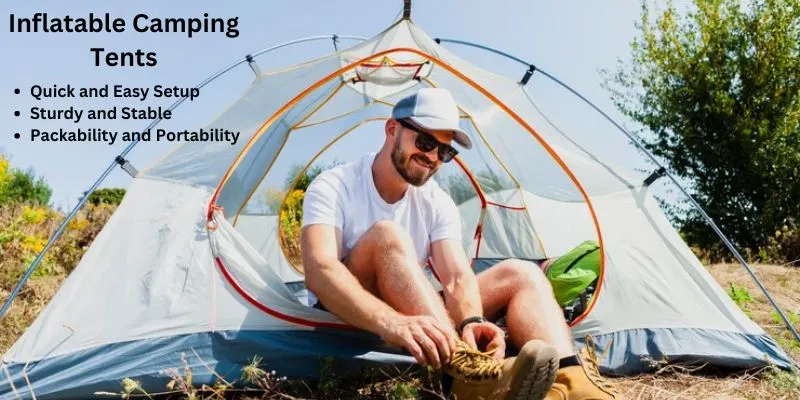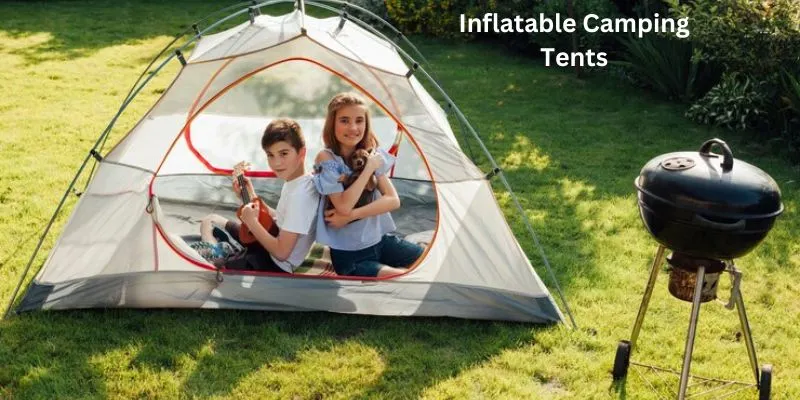5 Reasons Inflatable Camping Tents Are Game-Changers: Upgrade Your Campsite
Updated: 19 Aug 2024
214
Camping is all about connecting with nature, escaping the hustle and bustle of daily life, and creating lasting memories. And what better way to enhance your outdoor experience than with an inflatable camping tent? These innovative shelters have taken the camping world by storm, and for good reason.
Let’s talk about why inflatable tents are game-changers and how they can make your next camping adventure.
What is Meant By an Inflatable Camping Tent?
These tents are super fun and easy to set up. They might not be for grown-up adventurers, but they’re perfect for a backyard campout or adding some pizazz to your next family camping trip. And they enjoy the dinosaur camping tent.
Five Reasons for Inflatable Tent Camping
1. Quick and Easy Setup
Traditional tents often involve a complex dance of poles, stakes, and rainflies. Setting up inflatable tents is super easy. It’s a piece of cake! Inflatable tents allow you to spend less time pitching and more time enjoying the great outdoors.

2. Sturdy and Stable
Don’t be fooled by their airy appearance, and these tents are surprisingly sturdy. The secret to easy setup is in the special inflatable poles called air beams. These flexible beams provide ample support, even in windy conditions. Plus, attaching guy lines to anchor points ensures added stability. Different from traditional tents with stiff poles, inflatable tents can bend when the wind blows, so they don’t break as easily. Say goodbye to snapped fiberglass poles and hello to peace of mind.
3. Packability and Portability
Inflatable tents are lightweight and compact, making them ideal for backpackers and car campers alike. Whether you’re embarking on a multi-day trek or a weekend getaway, these tents won’t weigh you down.
4. Durability
Quality inflatable tents are built to withstand the elements. The materials used, such as durable fabrics and reinforced seams, ensure longevity. Whether you’re camping in rain, shine, or even light snow, your inflatable tent will keep you sheltered. Just remember to choose a model designed for the specific conditions you’ll encounter.
5. Safety First
Safety should always be a priority when camping. Inflatable tents eliminate the risk of sharp metal poles causing harm. No more accidental pokes or broken poles that render your tent useless. With inflatable tents, you can relax and enjoy s’mores by the campfire without stressing about tent maintenance.
Traditional Tents Vs. Inflatable Camping Tents
| Feature | Traditional Tents | Inflatable Camping Tents |
|---|---|---|
| Setup Time | Typically longer, requires manual assembly | Durable materials can withstand various weather conditions |
| Stability | May require additional support in windy conditions | Enhanced stability due to rigid inflatable structure |
| Weight | Generally heavier | Lightweight and easy to transport |
| Pack Size | Bulkier and may require more space | Compact when packed, easier for storage and transport |
| Durability | Subject to wear and tear over time | Inflation using an air pump or built-in inflation system |
| Setup Mechanism | Manual assembly using poles and stakes | Limited ventilation options may feel cramped |
| Comfort Features | Limited ventilation options, may feel cramped | Built-in ventilation, spacious interior |
| Weather Resistance | Varies depending on tent quality and materials | Designed to withstand rain, wind, and other weather conditions |
| Setup Difficulty | Requires some expertise and practice | Easy setup process, suitable for beginners |
| Environmental Footprint | Materials may include non-renewable resources | May use eco-friendly materials, depending on the brand |
Features to Consider When Choosing an Inflatable Camping Tent
1. Size and Capacity
- Determine how many people will be sharing the tent. Look for tents that comfortably accommodate your group size. Keep in mind that some tents have separate sleeping and living areas.
- Consider the tent’s height. A taller tent allows you to stand up inside, which can be a game-changer during extended trips.
2. Weight and Portability
- If you’re backpacking, opt for a lightweight and compact tent. Look for models that pack down small and won’t weigh you down on the trail.
- Car campers have more flexibility, but still consider ease of transportation and storage.
3. Ease of Setup
- Inflatable tents are known for their quick setup. Look for models with straightforward inflation systems (hand pump, electric pump, or self-inflating).
- Practice setting up the tent at home before your trip to ensure you’re familiar with the process.
4. Weather Resistance
- Check the tent’s waterproof rating (usually measured in millimeters). A higher rating means better water resistance.
- Look for tents with reinforced seams and a rainfly to keep you dry during rainy weather.
5. Ventilation and Condensation Management
- Proper ventilation prevents condensation buildup inside the tent. Mesh panels and windows allow airflow.
- Some tents have adjustable vents that you can open or close as needed.
6. Durability and Materials
- Quality materials are essential. Look for durable fabrics, robust zippers, and sturdy seams.
- Consider the tent’s lifespan—investing in a well-made tent pays off in the long run.
7. Interior Features
- Pockets and gear loops help keep your belongings organized.
- A vestibule provides extra storage space for muddy boots or wet gear.
- Reflective guy lines enhance visibility at night.
8. Seasonal Suitability
- Inflatable tents are versatile, but some are better suited for specific seasons.
- Three-season tents are ideal for spring, summer, and fall. Four-season tents handle winter conditions.
9. Price and Brand Reputation
- Set a budget and compare prices. Remember that quality often comes with a higher price tag.
- Research reputable brands are known for their reliable outdoor gear.
10. Reviews and Recommendations
- Read user reviews and seek recommendations from fellow campers.
- Websites like [Field Mag], [Campiffy], and [Modern Campground] offer valuable insights into large inflatable tent campings.
Tips for Maintaining and Caring for Inflatable Tent Campings
Inflatable tent campings offer a luxurious and convenient alternative to traditional pole tents. But like any outdoor gear, proper care is essential to ensure they last for years to come. Here are some key tips to maintain and care for your inflatable camping tent:
| Tips |
|---|
Set Up on Soft Ground
Mind the Sun
Maintain Proper Air Pressure
Keep it Clean
Deep Clean (Optional)
Dry Thoroughly
Store Properly
|
By following these simple tips, you can ensure your inflatable tent camping remains a comfortable and reliable home away from home for many adventures to come.
Testimonial About Inflatable Tent For Camping
“I’ve been using the Quechua Air Seconds 4.1 for several camping trips now, and I’m impressed by its simplicity and reliability. The inflatable structure makes setup a breeze, and the tent’s compact size and lightweight design make it easy to transport. It’s become my go-to tent for weekend getaways.”Mark Davis, Avid Camper
Environmental footprint of Inflatable Camping Tents
The environmental footprint of inflatable tent camping is an important aspect to consider:
1. Materials Used
Inflatable camping tents are typically made from a variety of materials, including fabrics like
- polyester
- nylon for the tent body
- PVC or TPU (thermoplastic polyurethane) for the inflatable beams or tubes.

PVC has caused worries because it’s bad for the environment. Making PVC, using it, and getting rid of it can release harmful chemicals. Also, PVC doesn’t break down naturally.
TPU, while still derived from petrochemicals, is considered more environmentally friendly than PVC, as it does not contain harmful chemicals like phthalates and can be recycled.
2. Production Process
The manufacturing process of inflatable tent camping involves
- energy consumption
- water usage
- the release of greenhouse gases and other pollutants.
Companies that prioritize sustainability may use more eco-friendly production methods, such as minimizing waste, reducing water usage, and sourcing materials from certified sustainable suppliers.
3. Longevity and Durability
One of the key advantages of inflatable tent camping is their durability, which can contribute to their overall sustainability. High-quality inflatable tents are designed to withstand harsh weather conditions and frequent use, potentially lasting longer than traditional tents. This longevity can reduce the need for frequent replacements, thereby minimizing waste and resource consumption over time.
4. End-of-Life Disposal
Disposal at the end of a tent’s life cycle is another factor to consider in assessing its environmental footprint. Even though inflatable tents are stronger than regular tents, they can still get worn out over time.
When it comes time to dispose of a camping inflatable tent, options for recycling or proper disposal can vary depending on the materials used.
Inflatable Tent For Camping Examples
| Category | Tent Name | Features |
|---|---|---|
| Family Camping | Coleman Quick Up Air Tent | Sleeps 6 people, spacious living area, weatherproof construction, electric pump included. |
| Lightweight Hiking | Nature hike Cloud Up 2 Person Tent | Ultra light and compact, easy to inflate/deflate, waterproof and windproof, perfect for backpacking. |
| Car Camping | Kelty Truman Air Tent | Sleeps 4 people, car-top compatible, large awning for shade, mesh panels for ventilation. |
| Winter Camping | Kwik Kamp Kodiak Tent | Insulated for 4-season use, snow skirt for added warmth, durable construction for harsh conditions. |
| Glamming | ALM Outdoors Monarch Air Tent | Spacious living area with standing room, large windows for views, queen-size air mattress included, perfect for luxurious camping. |
Conclusion
Make your camping trip better with an inflatable tent! They’re easy to put up, strong, and last a long time. Whether you’re a camping expert or just starting out, these tents will change how you enjoy the outdoors. An inflatable camping tent is like a house you can take with you. These tents are for people who love the outdoors and want to be comfy and happy. So, next time you’re planning a camping trip, consider ditching the traditional tent and embracing the inflatable revolution!
FAQs
How durable are inflatable camping tents?
Inflatable tents are built to last. They’re usually made with strong stuff like TPU or PVC for the air poles. To keep your tent in good shape, check for any holes and use a ground cover. This will help it last longer.
Are inflatable tents suitable for all weather conditions?
Inflatable tents can handle all kinds of weather. But it’s important to pick a tent made for the weather where you’ll be camping.
How do inflatable tents work?
Instead of regular poles, inflatable tents use air-filled poles to stand up. These air poles make the tent shape and keep it steady. It’s super easy and fast to set up this way!
Can inflatable tents withstand strong winds?
Even though inflatable tents are strong, really strong winds can be a problem. Make sure to tie it down really well and find a place away from the wind to put it.
What maintenance do inflatable tents require?
Regularly check for leaks and patch them promptly.Use a groundsheet to protect the tent floor.Store the tent properly to prevent damage.
Are inflatable tents suitable for backpacking?
Yes, their compact size and lightweight design make them ideal for backpackers seeking convenience and ease of setup.
Please Write Your Comments